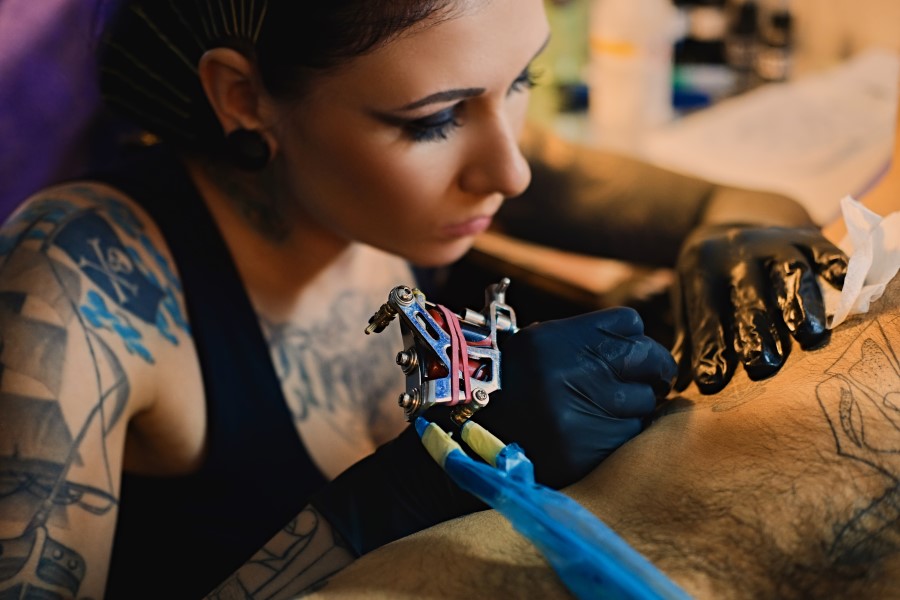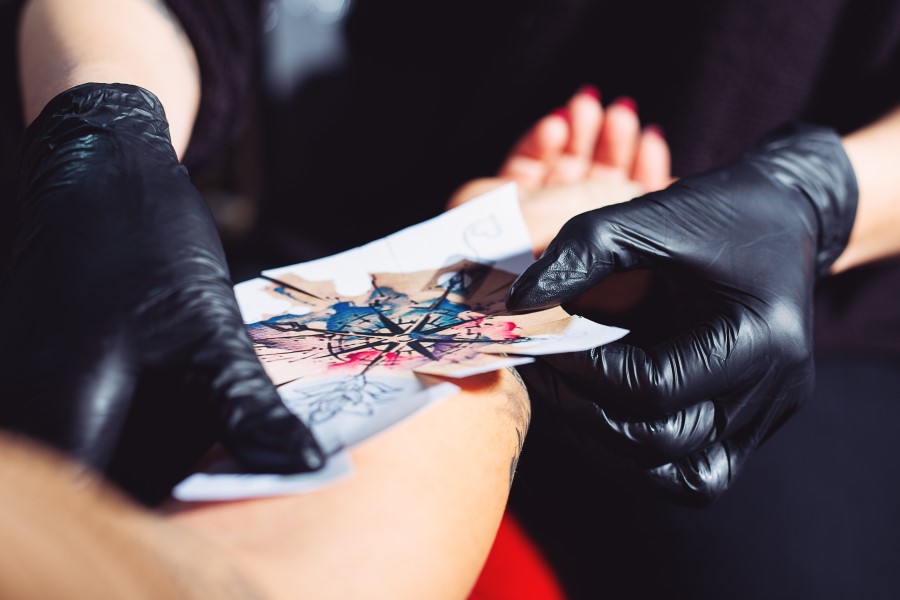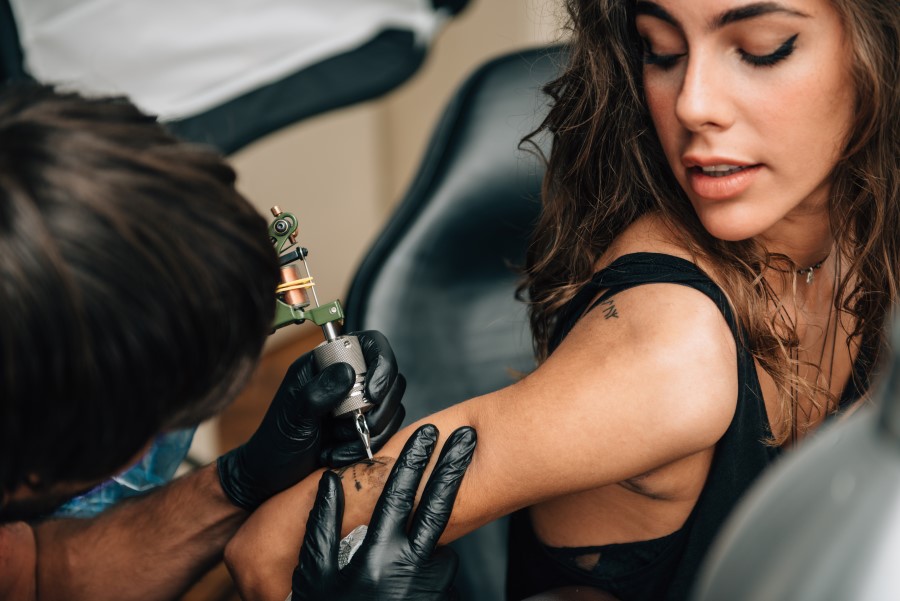A tattoo forever? This is often not the case. What you tattooed in your youth may no longer appeal to you at the age of 30, 40 or 50. Do not worry: you can hide your “sins of youth” with a cover-up tattoo.
A tattoo is a decision for life. But do you always know what you want? People change, and that is completely normal. Your personal development is continuous and then, at some point, old tattoos may no longer fit, which is totally natural. There are two ways to get rid of a tattoo – either you can have it removed by laser, or you can opt for a cover-up tattoo.
The right option for you depends not only on your personal preferences, but also on the type and size of your old tattoo and the area of the body where it is. In many cases, by the way, it comes down to a mixture: first, a laser is applied, then a cover-up tattoo is created. This is because, contrary to the grandiose promises made by many doctors, laser removal cannot be applied to all ink residues.
Table of contents
- Laser removal: how does it work?
- Not entirely safe, so please pay attention!
- Cover-up tattoos to turn old tattoos into new ones
- Cover-up tattoos do not always work!
- The details – how artists work
- Different techniques for covering
- These styles are suitable for cover-ups
- Even a cover-up tattoo needs looking after

Laser removal: how does it work?
If you are still convinced, even after much thought, that your old tattoo really has to disappear, then laser removal is probably the right choice. However, it can be painful and often takes longer than getting the tattoo. Nevertheless, laser treatments are considered to be safe compared to previously used methods with acid, files and/or liquid nitrogen.
The laser shoots intense and short flashes of light at a specific wavelength onto the tattoo from a very short distance. Light flashes are barely visible, but penetrate up to 4 millimeters deep into the skin. They shatter colour pigments into tiny fragments which the body breaks down via the lymphatic system. Most of these particles are excreted by the kidneys and intestines, whereas some pigments and fragments will probably remain in the body.
Needless to say, this is not done in a single session, but in several. Tne number of sessions you might need will depend on the size of the tattoo, as well as its age and motif. Some laser treatments take years. The situation is different if the laser treatment is “only” intended to prepare a tattoo for a cover-up one, which can usually be carried out in just a few sessions.
Your tattoo in 3 steps
In your first consultation you will receive personalized information on your tattoo. Contact us on our email address or superchat (bottom right symbol).
Make an appointment.
Your tattoo dream will be carried out in a relaxed atmosphere.

Not entirely safe, so please pay attention!
Laser tattoo removal is offered by many companies. However, only doctors are legally allowed to carry out these treatments. They do not have to work in a doctor’s surgery, but can be employed by a tattoo studio and offer other cosmetic treatments as dermatologists.
Make sure that the doctor treating you has the appropriate training on laser treatment, since lasers are dangerous. Medical high-quality laser systems are safe providing that they are operated correctly. If they are not operated correctly or other laser systems are used, the treatment is not safe, as it can cause burns, inflammation and pigmentation disorders, often resulting in scars. Under a law dated January 2021, laser removal must only be carried out by doctors with the appropriate training.

Cover-up tattoos to turn old tattoos into new ones
A cover-up tattoo is always used if you like tattoos in general but just cannot do anything with one motif. There are two options: the first one involves opting for a pure cover-up tattoo, in which case an old tattoo is incorporated into a new design as it is. This means it no longer stands out, but becomes a part of a new motif.
The second option consists in partially removing or fading an old tattoo by applying a laser treatment. What is left of it can then be integrated into the new tattoo, or the new tattoo covers the remains of the old one.
Cover-up tattoos require a lot of experience and artistic skills. Therefore, you should definitely look for an artist who has experience with cover-up tattoos. Only then can you be sure that the result will be convincing.

Cover-up tattoos do not always work!
A cover-up tattoo is not like a sticker that you simply place on an old tattoo so that it will disappear underneath. Old tattoos do not disappear at all, but hopefully blend seamlessly into the new tattoo. Therefore, the motif of the cover-up tattoo must not only suit you and your current life situation, but also be suitable for making the old tattoo fade into the background. “Putting something around it” is not enough. A cover-up tattoo is not a frame, but makes an old tattoo visually disappear.
This task is not easy. Take your time when looking for a tattoo artist. Cover-up tattoos are the supreme discipline in tattoo art. Take a close look at the repertoire of the artists concerned. Make sure that there is great chemistry between you and your artist. Lengthy discussions and recommendations to be considered thoroughly and then discarded are an essential part of the search for the right artist. Seek advice and ask questions.
Not unexpectedly, all this involves time, nerves and money, but it is worth it, since it avoids the risk of getting a cover-up tattoo in a few years’ time.
The details – how artists work
As stated above, by doing a cover-up tattoo, the artist integrates the old motif into the new one. Therefore, the new tattoo is significantly larger than the old one. Colours and shapes must match, although the style of the cover-up tattoo is often the same or very similar to your old one. A classic skull in black (realism) can somehow be integrated into an Asian tattoo. However, it might be difficult with other motifs.
The process can be described like this: the artist creates a motif to be placed on and around the old tattoo like a blanket, so that the old tattoo becomes a part of this “blanket”, which logically will be larger than the original tattoo. The new motif is designed in such a way that the focus is on a previously untattooed area – the eye is thus drawn away from the old tattoo.
The colours of the new tattoo must be chosen so that the old one can blend in. The pigments of the old and the new tattoo will mix, which is why a cover-up tattoo always requires several layers of colour. Some pigments can only be covered with black ink, whereas other pigments allow more possibilities. However, the cover-up tattoo will always be darker than the old one. This is why very dark tattoos are bleached by applying a laser treatment before the cover-up tattoo is done.
Different techniques for covering
There are very different ways to create a cover-up tattoo:
1. By improving existing motifs: if your tattoo has only lost a little colour and contour, you can simply touch it up. Then it will look new again.
2. By covering over original tattoos: small, light-coloured tattoos are suitable for this covering technique. The old motif is covered over with a new tattoo. Naturally, the new tattoo is larger and darker than the old one.
3. By integrating old tattoos into a new design: if you do not wish to or cannot completely cover your old tattoo, you can also have it integrated into a new motif. Sometimes this works wonderfully well stylistically (e.g. when the small, single rose on the forearm merges into a new carpet of flowers), but it can also be a total break in style, which is known as a blast-over.
These styles are suitable for cover-ups
Not every tattoo can be covered up. A few requirements must be met for the new tattoo to look really good. Important factors are size, colour, the depth of the old tattoo and your wishes regarding the new one. These requirements predestine your tattoo for a cover-up:
- The tattoo is rather small, there is a lot of free skin all around an area is easy to tattoo.
- Your tattoo is monochrome or designed with few colours and is rather bright.
- Your tattoo is already a little faded and looks “airy”.
- Your tattoo consists of simple letters, numbers or lettering that your artist transforms into a colourful motif.
- Curved lines and shadows can be easily incorporated into a new motif (the aforementioned rose is one such motif) or can be concealed in the dark shadows of a new motif.
Intricate styles such as dotwork can be better hidden with a cover-up tattoo, but you cannot make a massive tattoo disappear with dotwork. The style of the new motif will always be traditional, neo-traditional or tribal, biomechanical being also suitable.
Even a cover-up tattoo needs looking after
Just like your first tattoo, your cover-up tattoo also needs looking after. After all, the motif should retain its intense colour for a long time and its contours should remain clear and distinct. Make sure that the cover-up tattoo heals well!
Moreover, you can also make unsightly scars resulting from accidents or burns disappear under a tattoo. However, the scar must be completely healed for this. Make sure you find a tattoo artist who has experience with the different skin structures of scar tissues and can deal with it. Scar tissues heal differently, so a cover-up tattoo will probably take several sessions and months to heal.

